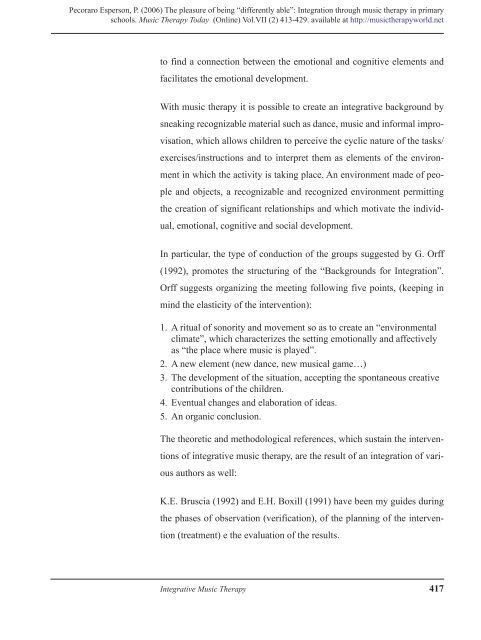Music Therapy Today - World Federation of Music Therapy
Music Therapy Today - World Federation of Music Therapy
Music Therapy Today - World Federation of Music Therapy
Create successful ePaper yourself
Turn your PDF publications into a flip-book with our unique Google optimized e-Paper software.
Pecoraro Esperson, P. (2006) The pleasure <strong>of</strong> being “differently able”: Integration through music therapy in primary<br />
schools. <strong>Music</strong> <strong>Therapy</strong> <strong>Today</strong> (Online) Vol.VII (2) 413-429. available at http://musictherapyworld.net<br />
to find a connection between the emotional and cognitive elements and<br />
facilitates the emotional development.<br />
With music therapy it is possible to create an integrative background by<br />
sneaking recognizable material such as dance, music and informal impro-<br />
visation, which allows children to perceive the cyclic nature <strong>of</strong> the tasks/<br />
exercises/instructions and to interpret them as elements <strong>of</strong> the environ-<br />
ment in which the activity is taking place. An environment made <strong>of</strong> peo-<br />
ple and objects, a recognizable and recognized environment permitting<br />
the creation <strong>of</strong> significant relationships and which motivate the individ-<br />
ual, emotional, cognitive and social development.<br />
In particular, the type <strong>of</strong> conduction <strong>of</strong> the groups suggested by G. Orff<br />
(1992), promotes the structuring <strong>of</strong> the “Backgrounds for Integration”.<br />
Orff suggests organizing the meeting following five points, (keeping in<br />
mind the elasticity <strong>of</strong> the intervention):<br />
1. A ritual <strong>of</strong> sonority and movement so as to create an “environmental<br />
climate”, which characterizes the setting emotionally and affectively<br />
as “the place where music is played”.<br />
2. A new element (new dance, new musical game…)<br />
3. The development <strong>of</strong> the situation, accepting the spontaneous creative<br />
contributions <strong>of</strong> the children.<br />
4. Eventual changes and elaboration <strong>of</strong> ideas.<br />
5. An organic conclusion.<br />
The theoretic and methodological references, which sustain the interven-<br />
tions <strong>of</strong> integrative music therapy, are the result <strong>of</strong> an integration <strong>of</strong> vari-<br />
ous authors as well:<br />
K.E. Bruscia (1992) and E.H. Boxill (1991) have been my guides during<br />
the phases <strong>of</strong> observation (verification), <strong>of</strong> the planning <strong>of</strong> the interven-<br />
tion (treatment) e the evaluation <strong>of</strong> the results.<br />
Integrative <strong>Music</strong> <strong>Therapy</strong> 417

















